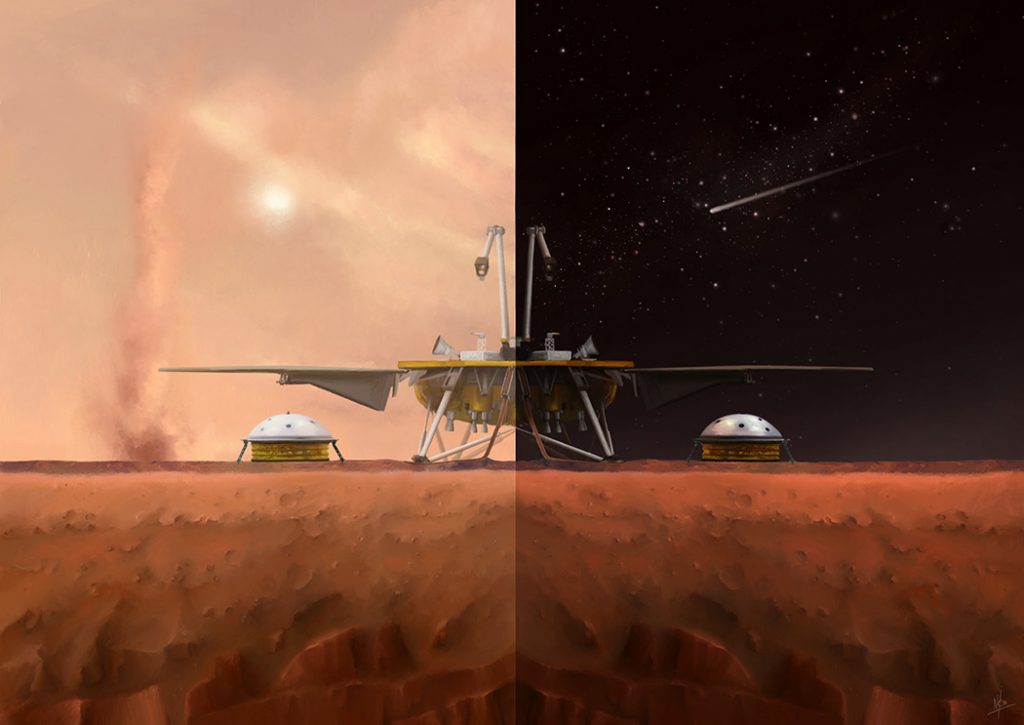InSight/SEIS probes further into the heart of Mars
A look back at this scientific result, released one year after the landing of the InSight probe on Mars, and the start of recordings by SEIS, the French seismometer that measures the activity of the Martian soil.

In a series of 6 papers published on Monday 24 February 2020 in Nature Geoscience and Nature Communication, the science team of NASA’s InSight mission begins to unravel the mysteries of Mars. The extensive geophysical data collected during the first six months of the mission shed light on the structure of the first few kilometres of the Martian subsurface and provide a new understanding of atmospheric phenomena on the planet’s surface.
Researchers at the Paris Institute of Earth Physics are particularly interested in the seismicity of Mars and the first Martian seismo-tectonic analyses, the internal crustal structures imaged by these first data, and the interaction of the Martian atmosphere with the subsurface of Mars.
By scrutinizing the records of the SEIS seismometer, deployed on the Martian surface since December 2018, seismologists, including IPGP researchers, have indeed identified nearly 460 seismic events in mid-February. 40 of these are low-frequency signals, corresponding to relatively deep earthquakes, while the vast majority are high-frequency events, much more superficial and nearby, the origin of which is still unclear: small surface earthquakes, landslides and cliff microbursts are candidate sources.
Seismic waves from earthquakes, sensitive to the materials they pass through, offer planetary scientists a means of studying the composition of the planet’s internal structure. By combining them with other sources of vibrations (from the lander and its instruments or from the dust devils that criss-cross the Elysium plain), researchers from the Mars Structure Service, coordinated by the IPGP and the Jet Propulsion Laboratory, have been able to differentiate 3 distinct layers in the subsurface: the duricrust, an indurated layer of a few centimetres; the regolith, a superficial stratum formed of materials crushed by countless impacts over billions of years, and finally a layer of about ten kilometres altered by several billion years. Underneath these ten kilometres is a consolidated deep crust, where the observed scattering and attenuation of seismic waves resembles that observed in Earth’s crystalline massifs.
While the Martian crust is beginning to reveal its secrets, the seismic events detected so far do not yet allow us to illuminate the interior of Mars, and to ‘illuminate’ the mantle and core. However, the first results provided by the SEIS seismometer during its first year of operations on Mars are very encouraging, and Martian seismology is already stimulating new lines of research, ultimately leading to a better understanding of the formation of all rocky planets, including the Earth and its Moon.
Références :
Lognonné, P., W. B. Banerdt, W. T. Pike, D. Giardini, U. Christensen, R. F. Garcia, T. Kawamura, et al. « Constraints on the Shallow Elastic and Anelastic Structure of Mars from InSight Seismic Data ». Nature Geoscience 13, no 3 (mars 2020): 213‑20. https://doi.org/10.1038/s41561-020-0536-y
The LabEx UnivEarthS contributed to this research by funding the ex-Interface project “Fundamental physics and Geophysics in space” (I3)
This text is partly taken and translated from the press release published by IPGP when the articles were published. For the full press release, go here.
- 4.5 billions years ago, the Earth’s early atmosphere was similar to present Venus [1/10]
- Observing supernovae: neutrino detectors to the rescue [2/10]
- At the origins of the Solar System, millimetre-sized crystals at the heart of certain meteorites [3/10]
- Kinetic Inductance Detectors, a promising technology for precision astronomy [4/10]
- Light-speed seismology to prevent earthquakes [5/10]
- ATHENA, a technical challenge for the new generation of X-ray telescope [6/10]
- Dune fields, a key to understanding the climate of other “Earths” in the Solar System [7/10]
- SVOM/ECLAIRs space instrument will pave the way to a deeper understanding of ultra-long gamma-ray bursts [8/10]
- InSight/SEIS probes further into the heart of Mars [9/10]
- The search for dark matter compatible with the search for supernovae [10/10]
